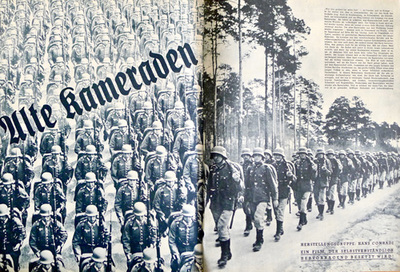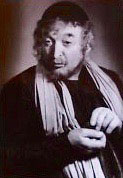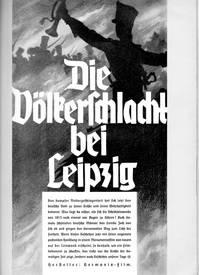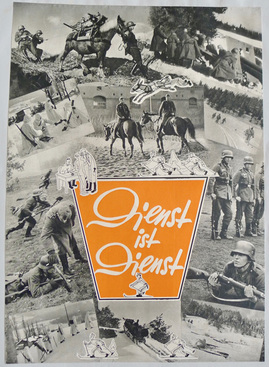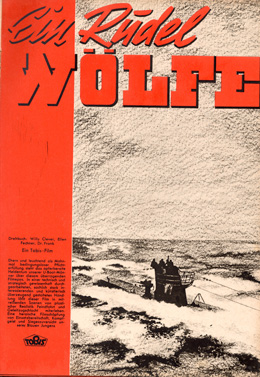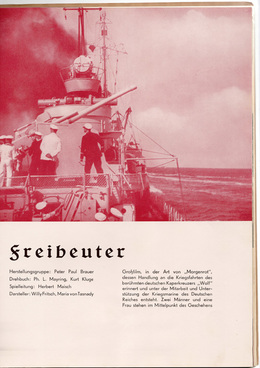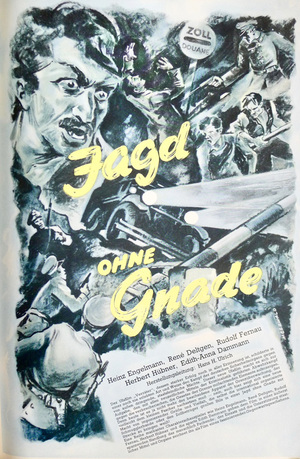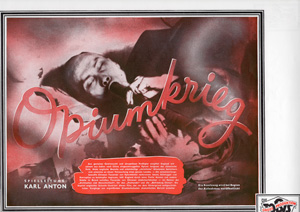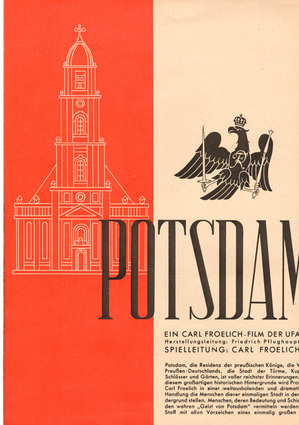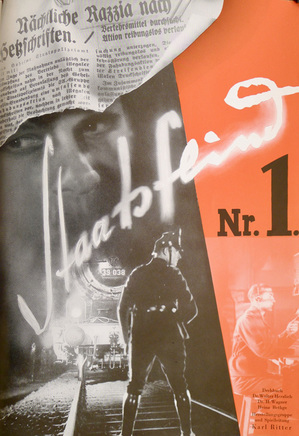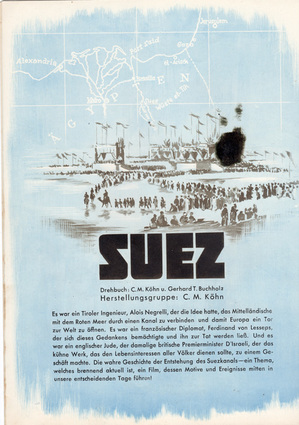- Home
- POSTER GALLERY
- ❗️BOOK & POSTER STORE❗️
- About the Posters
- The William Gillespie Collection
- Our Publishing House
- ❗️GFDN interviews author and collector William Gillespie ❗️
- Our most expensive & inexpensive finds!
- ❗️***NEW!*** Poster of the Month ❗️
- ❗️NEW ❗️Film Posters – Demands on an important means of film advertising. ❗️
- In our Book + Zeitschrift Library
- ❗️ ***NEW!*** Hitler Youth Quex – A Guide for the English–speaking Reader ***NEW!*** ❗️
- ❗️***NEW!*** Table of Contents of our new HJ QUEX book❗️
- ❗️Hitler Youth Quex Guide - early praise! ❗️
- Recent loans from the Collection
- Farewell Horst Claus. (1940–2024)
- "Der Deutsche Film" Zeitschrift
- ❗️ ***NEW!***German "Tendency" Films (Tendenzfilme) in the Third Reich ❗️
- KARL RITTER
- Karl Ritter original film posers in this Collection
- "Besatzung Dora" ( † 1943)
- "The Making of The Crew of the Dora"
- Karl Ritter at the 1938 Reichsfilmkammer Congress
- INDEX -"Karl Ritter" book, 2nd edition
- Karl Ritter's Legion Condor (1939, unfinished)
- Excerpt from our "Dora" book
- ∆∆∆∆∆ High praise for our DORA book! ∆∆∆∆∆
- TABLE OF CONTENTS – "Legion Condor"
- § § § § § Early Praise for our LEGION CONDOR book! § § § § §
- ❗️"Das Leben geht weiter" and Karl Ritter ❗️
- Zarah Leander Europe–wide !
- Japan Military Film and Karl Ritter
- Karl Ritter after 1945
- 1935 Film Congress
- Poster Exhibition in Berlin, March 1939
- Potsdam poster exhibition 12 April–25 August 2019
- Leni Riefenstahl's two "Olympia" Films (1938)
- "Ohm Krüger" (1941)
- Emil Jannings
- "Blutendes Deutschland" (1933)
- Hannes Stelzer ( † 1944)
- Klaus Detlef Sierck ( † 1944)
- Film stills
- Reich Film Censorship Offices
- ❗️Dateline: Ufa - April 11, 1945 ❗️
- ❗️***NEW!***The Fate of the German Film Industry in May 1945 ❗️
- Film censorship cards
- Film Archives
- Cinema advertising
- School filmstrips
- ❗️UPDATED❗️ Z F O / Ostland Film G-m-b-H
- Z F O / Herbert Jacobi estate
- ZFO / Ostland Film newspaper articles
- ❗️***NEW!*** Roter Nebel / Red Fog / Red Mist (1942/1943, ZFO) ❗️
- ZFO - Der Rückkehrer - The Returnee (1943/1944)
- The D F G production company
- D I F U
- ❗️ ***NEW!*** "Carl Peters" – Special Collection. ❗️
- "Alcazar" (1940, Genina)
- "Der 5. Juni" (1943, banned)
- ❗️ ***NEW!*** Herbert Selpin and his "Titanic" (1943) ❗️
- ❗️ ***NEW!*** Ein Robinson (1940, Fanck) ❗️
- "Fronttheater" (1942)
- Veit Harlan's Jud Süß and Fritz Hippler's Der Ewige Jude
- Harlan "Jud Süß" trial 1949
- Werner Krauss & JUD SÜß
- Anti-Semitic Film Posters in the Collection
- "Heimkehr" (1941)
- "Hitlerjunge Quex" (1933)
- ❗️***NEW!*** Hitlerjunge Quex in 111 Greater Berlin Cinemas ❗️
- Jürgen Ohlsen
- "S.A.Mann Brand" (1933)
- "In der roten Hölle" (Edgar Neville, 1939)
- "Helden in Spanien" (1938)
- The Spanish Civil War in Film
- Andrews Engelmann (1901 – 1992)
- Deutsche Wochenschau
- Uƒa Feldpost
- Uƒa Kulturfilm – Informationen
- " Die Tochter des Samurai" (1937, Fanck)
- Ufa 25th Anniversary
- Invitations to world premieres
- ❗️***NEW!*** Continental Films, Paris 1940–1944 ❗️
- Film Censorship in Occupied Paris 1942
- "Der Sieg des Glaubens" (1933)
- Wilhelm Althaus Estate
- Weimar Germany posters
- Ufa and the Ordensburgen
- The Gaufilmstelle in our Collection
- "Zwei Welten" (1940)
- "Capriccio" (1938) –Karl Ritter film album
- Unrealised NS Propaganda Films 1934–1945
- German Film Directors accused of "war crimes"
- Australian––themed NS feature films
- "Der Störenfried" / "The Troublemaker"
- What was new in 2014?
- What was new in 2015?
- What was new in 2016?
- What was new in 2017?
- What was new in 2018?
- What was new in 2019?
- What was new in 2020?
- What was new in 2021?
- What was new in 2022?
- What was new in 2023 ?
- What's new in 2024?
- ❗️***NEW!*** Hitler assassination attempt in Karl Ritter film cut❗️
- BESATZUNG DORA private photos
- Just discovered 1942 article on BESATZUNG DORA
- The Karl Ritter Tetralogy
- Google Analytics 2023
- Our first–ever acquisition!
- ❤️"Some of our favourite things....!"❤️
- ERRATUM for our " Hitler Youth Quex Guide"
- Trending
- Vale †
- Our Wants List / 2024 / Wunschliste
- Pop Quiz
- Unsere KARL RITTER Bücher in Deutschland liefbar!
- WHERE to buy our books right now?
- ✉️Contact
 “History is not about the facts. It is about the context and who is telling the story.” —Prof. Milton Fine.
“History is not about the facts. It is about the context and who is telling the story.” —Prof. Milton Fine.
"Who controls the past controls the future: who controls the present controls the past." –– George Orwell in his novel "1984."
"Whoever doubts the exclusive guilt of Germany for the Second World War destroys the foundation of post–war politics." –– Prof. Theodor Eschenberg, Rector, the University of Tübingen.
"If we have our own why in life, we shall get along with almost any how." – Friedrich Nietzsche
POSTER GALLERY --view
over 500 German film
original posters between
1927–1954 from
Germany and from
many Axis and Neutral countries
across Europe!
Note! Posters in the Poster Gallery are PERMANENT
acquisitions which are NOT FOR SALE!! ONLY the
posters listed in our POSTER STORE are for sale.
(They have a price and order button to use.)
Unrealised NS propaganda films 1934 – 1945
From our Library's film studio publications we present here over two dozen propaganda films announced, but then never produced during the Third Reich. Two of the films did actually commence filming (Legion Condor, Der letzte Appell) but then were abandoned, and no film fragments survived. The other films were never started, most without having even listed the intended cast, and some without the intended Director named, either.
There are of course other non–propaganda films which were also announced in annual preview publications meant for the film industry and cinema owners, but we have not listed entertainment films, musicals, comedies and lighter fare. Some of those films, such as Mona Lisa starring Zarah Leander, or Julius Caeser starring Gustav Gründgens, are of note.
The propaganda films:
Alte Kameraden (Old Comrades) – Terra Filmkunst 1938/39
This film was advertised in a double-spread in the 1938/39 Tobis Filmkunst annual preview book without mentioning any Director, or artists, under the Production Head Hans Conradi. The description is of soldiers who fought in WWI now being joined by younger recruits in the Third Reich; that the young men can learn from the older generation, but that “the world does not stand still, even in the barracks.” “Together, with the young soldiers, the great feeling overcomes them that they are to be the sons of an eternally young people, a Germany risen in beauty.”
Bayreuth (Bayreuth) – Tobis Filmkunst 1940/41
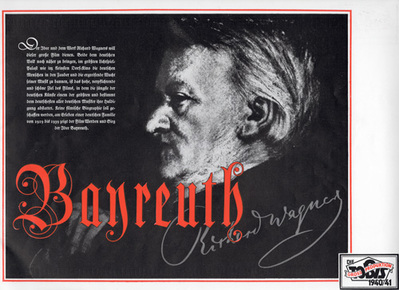 Rather than a cinematic biography this film was intended to portray a family between the years 1919 and 1939 as the ideas and spirit of the great composer and his legacy in Bayreuth took shape. Although no Director was mentioned in this wartime announcement, Hans Steinhoff had been planning such a film five years earlier for Hammer Tonfilm (see the listing for that earlier attempt under the film title Richard Wagner, below.)
Rather than a cinematic biography this film was intended to portray a family between the years 1919 and 1939 as the ideas and spirit of the great composer and his legacy in Bayreuth took shape. Although no Director was mentioned in this wartime announcement, Hans Steinhoff had been planning such a film five years earlier for Hammer Tonfilm (see the listing for that earlier attempt under the film title Richard Wagner, below.)
Das große Spiel ("Secret Service") – Tobis Fimkunst 1940/1941

This film is not to be confused with the René Deltgen soccer film using the same title, which appeared in July 1942 from Bavaria Filmkunst.
As can be seen at left, this film was to star Ferdinand Marian (Jud Süß) and Olga Tschechova (Der Fuchs von Glenarvon) with the Director and other Cast members to be announced shortly. The text reads:
Like lies, betrayal, arson, occupation and kidnapping, assassination is one of the weapons of the notorious "Intelligence Service" with which English politics has created an unscrupulous instrument for its dark activities in the world. Since the confessions of the successful agent T.E. Lawrence sensed the world of the importance, power, and mission of this organization. With the relentless exposure of their "work" in recent years through German publications, they have become a terrifying certainty. In this film, the essence and workings of the Intelligence Service are examined within the framework of a strong dramatic plot and the necessity of the destruction of this terror organization in the interest of world peace is shown.
Der Kaufmann von Venedig (The Merchant of Venice) – Ufa 1945
This production was to star Werner Krauss as Shylock in an Agfacolor Film directed by Veit Harlan, with his wife Kristina Söderbaum cast as Lady Southampton. Krauss had become infamous for his extremely anti–Semitic interpretation of Shylock in Viennese stage performances of the Shakespeare play, here shown in character in this 1943 stage photograph of the actor. This description is from the Deutsche Filmkunst 1945 book published in mid–1944 for the film distributors. It was the last major such film book printed in the Third Reich.
Die letzte Appell (The last roll call) – Tobis Filmkunst 1939
Film stars Werner Krauss and Emil Jannings were meant to play the two 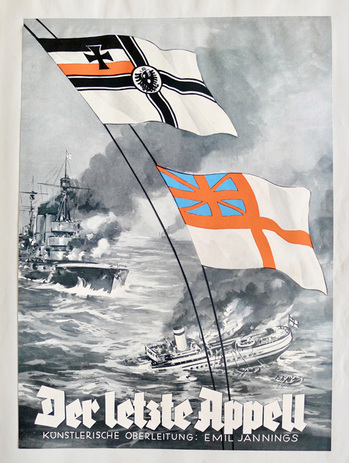 opposing enemy captains in this WWI melodrama, to be directed by Max Kimmich, whose anti–British films My Life for Ireland and The Fox of Glenarvon are well–known. The story tells of the German steamer ship ‘Königen Luise’ laying mines in the North Sea to hinder British naval vessels, and the British destroyer ‘Amphion’ attacking and sinking her. The German ship captained by Jannings, the British one by Krauss. There was a human-interest sub–plot as the daughter of Jannings’ character was married to an officer of the British Navy; and the son of Janning’s character was aboard the ‘Königin Luise’ as a young sailor under his father’s command.
opposing enemy captains in this WWI melodrama, to be directed by Max Kimmich, whose anti–British films My Life for Ireland and The Fox of Glenarvon are well–known. The story tells of the German steamer ship ‘Königen Luise’ laying mines in the North Sea to hinder British naval vessels, and the British destroyer ‘Amphion’ attacking and sinking her. The German ship captained by Jannings, the British one by Krauss. There was a human-interest sub–plot as the daughter of Jannings’ character was married to an officer of the British Navy; and the son of Janning’s character was aboard the ‘Königin Luise’ as a young sailor under his father’s command.

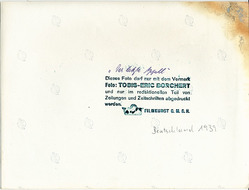
The film commenced filming in July 1939 in Kiel, but then was suspended due to increased German Navy activities in preparation for the Polish campaign. During the filming, on 28 July 1939, with the entire film crew and stars present, a heavy artillery shell suddenly exploded on-board the steamer ‘Reiher’ used for the movie. Luckily nobody was injured. By the time filming might have resumed in March 1940, having cost RM 1 million to date, the film was abandoned. No fragment of the unfinished film apparently exists.
Die letzte Nachwuch (The Last Rear Guard) – Hammer Tonfilm 1935/36
Following the huge success of the WWI Hans Zöberlein film Stosstrupp 1917, The Last Rearguard was announced; with the storyline commencing 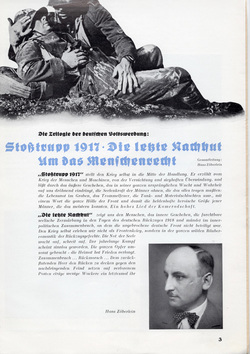 at that war’s end: “The Last Rearguard” shows us the people, the inner events, the terrible mental attrition in the days of the German retreat in 1918 and culminates in the internal political collapse, in which the unbroken German front was not involved. We do not experience the war itself as a front war, but in the whole wild robber romance of the rearguard action. The years of struggle seem pointless. The whole sacrifice brought in vain – the homeland demanded peace.” Due to financial pressures, the film was never produced. After Hammer Tonfilm recovered, the film Um das Menschenrecht (The Rights of Mankind) was produced and it then incorporated material meant for the cancelled film, to continue the story of Germany’s woes in the post–1918 surrender years. Had the Last Rearguard been produced, the Director was meant to be Zöberlein again.
at that war’s end: “The Last Rearguard” shows us the people, the inner events, the terrible mental attrition in the days of the German retreat in 1918 and culminates in the internal political collapse, in which the unbroken German front was not involved. We do not experience the war itself as a front war, but in the whole wild robber romance of the rearguard action. The years of struggle seem pointless. The whole sacrifice brought in vain – the homeland demanded peace.” Due to financial pressures, the film was never produced. After Hammer Tonfilm recovered, the film Um das Menschenrecht (The Rights of Mankind) was produced and it then incorporated material meant for the cancelled film, to continue the story of Germany’s woes in the post–1918 surrender years. Had the Last Rearguard been produced, the Director was meant to be Zöberlein again.
Die Roten Streife (The Red Stripes) – Tobis Filmkunst 1941/42
This 1942 film was intended to star Heinrich George as an embittered 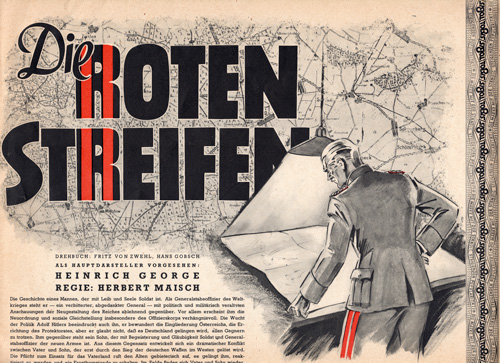 WWI General who views the new structure and social equality of the officer corps as flawed. Although he marvels at the integration of Austria into the Reich and the establishment of the Protektorat in former Czech lands, he is doubtful that Germany will succeed against its enemies. His son, as a young officer in the new Wehrmacht, opposes him. When the old man is called back to service, a dramatic conflict between father and son unfolds, which is only resolved following the victories of Germany on the Western Front. The Director was meant to be Herbert Maisch, whose DIII88 was a very successful major Luftwaffe film.
WWI General who views the new structure and social equality of the officer corps as flawed. Although he marvels at the integration of Austria into the Reich and the establishment of the Protektorat in former Czech lands, he is doubtful that Germany will succeed against its enemies. His son, as a young officer in the new Wehrmacht, opposes him. When the old man is called back to service, a dramatic conflict between father and son unfolds, which is only resolved following the victories of Germany on the Western Front. The Director was meant to be Herbert Maisch, whose DIII88 was a very successful major Luftwaffe film.
Die 7. Großmachte (The 7 Great Powers) – Tobis Filmkunst 1939/40
This film was purportedly an idea of Dr. Goebbels’, telling the story of the 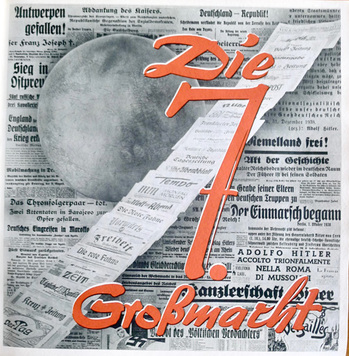 German press through the family Hille “over the past, the present and the future.” Friedrich Hille, a typesetter, “experiences having children, war, blindness and catastrophe, love, and a lucky turn of events." He endures this at his typesetting machine, and "it is our own destiny whose type he sets.” At story’s end Hill is to be seen working for the NSDAP's Völkischer Beobachter. The Director was announced as Hans Steinhoff.
German press through the family Hille “over the past, the present and the future.” Friedrich Hille, a typesetter, “experiences having children, war, blindness and catastrophe, love, and a lucky turn of events." He endures this at his typesetting machine, and "it is our own destiny whose type he sets.” At story’s end Hill is to be seen working for the NSDAP's Völkischer Beobachter. The Director was announced as Hans Steinhoff.
Die Volkerschlacht bei Leipzig (The Battle of Leipzig) – Hammer Tonfilm 1935/36
The 1813 battle which was a turn of fate for the German people was to be re–told in this “monumental historical film – a film document which not only shows the greatness of that time, but also is a history of our own time.” Neither the film’s Director nor actors were announced. The production company was named as Germania–Film.
Dienst ist Dienst (Service is Service) – Tobis Filmkunst 1938/39
This film was announced to premiere in February 1939, but was never made. It was to tell the story of mountain troops in the German Alps – “in the spirit of our new Wehrmacht, and brings an interesting, entertaining diversion of humour, sport and (military) service in equal measure.” The Director was named as Franz Seitz, who produced and directed SA Mann Brand in 1933.
Ein Rüdel Wolfen – (A Pack of Wolves)– Tobis Filmkunst 1942/43
"Brave and shining as a monument to the unconditional fulfilment of duty stand the readiness–to–sacrifice heroism of our U-Boat men in this outstanding film epic.
An heroic cinematic work of combat readiness, fighting spirit, and confidence of victory of our young sailors."
No Director or cast listed.
Einer gegen England – Thomas Paine (One Against England – Thomas Paine) – Tobis Filmkunst 1941/42
The story of the American patriot Paine and his fight against ‘the power of the moneybag’ of British tyranny; and as one of the most important fighters alongside Washington. “Whereas the Paris of the French Revolution celebrates him as one of America’s greatest heroes; envy, ingratitude, enmity in the country of adoption strike Paine in the darkness of oblivion, his great love becomes a source of tragic suffering. Forgotten, unknown, impoverished, Paine returns home to America, an old, tired, beaten man.” The Director named was Wolfgang Liebeneiner, and the title role to be portrayed by Ewald Balser, whose depiction of Rembrandt is unforgettable.
Here another anti–British film, to have starred Hans Albers as a privateer 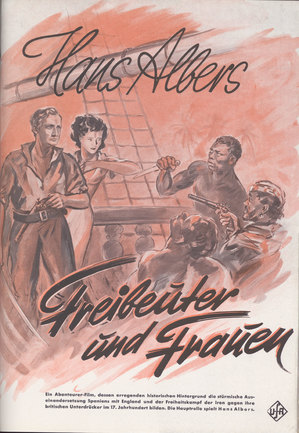 in Buccaneer und Women.... "which presents the stormy confrontation between Spain and Brtain and the Irish freedom struggle against British oppression in the 17th Century, with Hans Albers in the title role."
in Buccaneer und Women.... "which presents the stormy confrontation between Spain and Brtain and the Irish freedom struggle against British oppression in the 17th Century, with Hans Albers in the title role."
Feind am Werk (Enemy at Work) – Tobis Filmkunst 1941/42
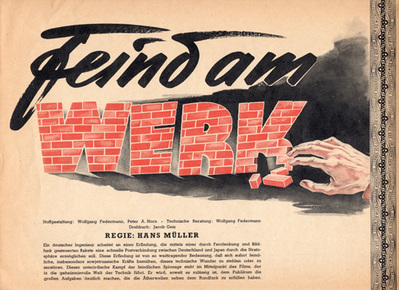 “A German engineer works on his invention that by remote control and radio-controlled rocket allows a rapid postal service connection between Germany and Japan through the stratosphere. This discovery is of such exceptional importance that immediately enemies, especially Soviet forces, endeavour to steal this technical wonder, or destroy it. This underground battle of enemy espionage is the focus of this film, that leads us to the secret world of technology.” The Director was named as Hans Müller.
“A German engineer works on his invention that by remote control and radio-controlled rocket allows a rapid postal service connection between Germany and Japan through the stratosphere. This discovery is of such exceptional importance that immediately enemies, especially Soviet forces, endeavour to steal this technical wonder, or destroy it. This underground battle of enemy espionage is the focus of this film, that leads us to the secret world of technology.” The Director was named as Hans Müller.
Flandern (Flanders) – Hammer Tonfilm 1935/36
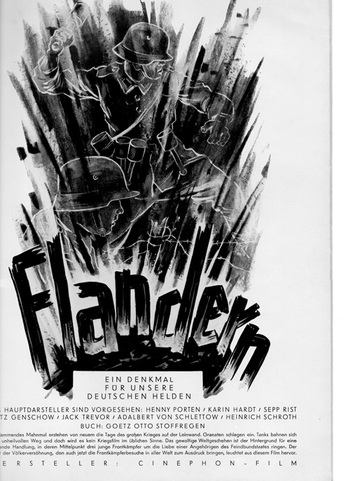 “A major new monument on the screen to the days of the Great War. Grenades are thrown, tanks make a sinister journey and yet this is no ordinary war film of the customary manner. The powerful world events are the background for a thrilling story of three young front fighters who throng for the love of a member of the enemy federal state.” The Director was named as Goetz Otto Stoffregen, and actors listed included Henny Porten, Karin Hardt, Sepp Rist, Fritz Genschow, Jack Trevor.
“A major new monument on the screen to the days of the Great War. Grenades are thrown, tanks make a sinister journey and yet this is no ordinary war film of the customary manner. The powerful world events are the background for a thrilling story of three young front fighters who throng for the love of a member of the enemy federal state.” The Director was named as Goetz Otto Stoffregen, and actors listed included Henny Porten, Karin Hardt, Sepp Rist, Fritz Genschow, Jack Trevor.
Frauen für Übersee (Women for Overseas) – Tobis Filmkunst 1941/42
“Young German women and girls – Daughters and nieces of German colonial pioneer families, band together to devote themselves with only one aim: to the task of being prepared to be deployed to the re–won 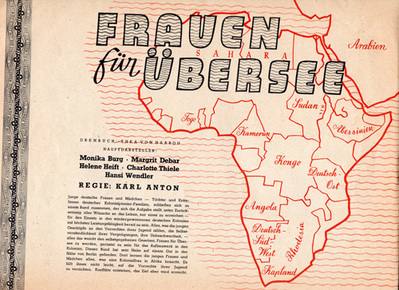 German colonies, after re–thinking their wishes in life. All this gives way to the self–given command of being prepared for integration into the colonies. The group has its home on an estate near Berlin. Here the young women and girls learn everything that a colonial woman in Africa needs. It is not easy to renounce the privilege of their youth. Conflict arises but the goal is reached.” The Director was named as Karl Anton. Stars listed were to be Monika Berg, Margrit Debar, Helene Heift, Charlotte Thiele, Hansi Wendler.
German colonies, after re–thinking their wishes in life. All this gives way to the self–given command of being prepared for integration into the colonies. The group has its home on an estate near Berlin. Here the young women and girls learn everything that a colonial woman in Africa needs. It is not easy to renounce the privilege of their youth. Conflict arises but the goal is reached.” The Director was named as Karl Anton. Stars listed were to be Monika Berg, Margrit Debar, Helene Heift, Charlotte Thiele, Hansi Wendler.
Freibeuter (The Privateer/Buccaneer) – Ufa 1937/38
“A major film, like Morgenrot, whose plot follows the war travels of the renowned raider ‘Wolf,’ produced with the collaboration and support of the German Navy. Two man and a woman are the focus of what happens.” The Director was meant to be Herbert Maisch (DIII88), starring Willy Fritsch and Maria von Tasnady.
Jagd ohne Gnade (Hunt without Mercy) – first announced for Ufa 1939/40; then for 1940/41.
“The Ufa film Verräter (Traitor), whose huge success is still remembered, portrayed in a heretofore not experienced manner the fight of the German secret service against foreign enemy powers. This new Ufa film sets itself the task of demonstrating the defensive action against the criminal elements that offend the border laws, which is carried out with all modern means of criminal investigation. Because today it is no longer the modest apparatus of border surveillance which may have to follow the little smuggler – no, here is a new power of imposing greatness and diversity, which knows how to hunt down even the internationally organized smugglers gang or the big-ticket customs fraudsters in a hunt without mercy!” The film was meant to star Heinz Engelmann, René Deltgen, Rudolf Fernau, Herbert Hübner and Edith–Anna Dammann. The Producer was named as Hans H. Ulrich but the intended Director was not listed.
Kapitan Boykott (Captain Boycott) – Terra Filmkunst 1940/41
“Summer 1880. The Irish representative of his people in Parliament in London portrays the suffering of his people. A promise is made to “examine the situation.” The British representative arrives at his Irish quarters; his name is Captain James Boycott, an Englishman and landowner. The information he receives is as was expected in London: The Irish are lazy and defiant, so the reins must be tightened more than before. The only person who told the truth to the representative is Parnell, an attorney and friend of Gerty, the daughter of Boycott. He is not listened to, and in the end, leaves the house. An assassination attempt, prompting the Commissioner to leave immediately, is the welcome excuse to harass the Irish even more. A decisive debate between Parnell und Gerty takes place, but he remains firm and then organizes the passive resistance against Boycott and his men. Workers, who are brought in from abroad, are seized by the freedom movement after a few days. This passive resistance called "boycotting" ruins the Englishman. Captain Boycott leaves the country, he is a beaten man. For the first time in the history of the enslaved Ireland, this downtrodden nation has triumphed over the English oppressor – a current film, strong in its effects, because it combines the evocative motive with aroused human individual destinies.” The film’s Director was not listed but the film was to have starred Heinrich George, René Deltgen and Leny Marenbach. Production Head was named as Eduard Kubat.
Legion Condor (Condor Legion) – Ufa 1939
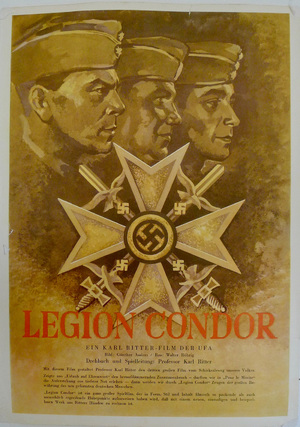 This Karl Ritter film, planned as the official sequel to his box–office hit Pour le Mérite, was abandoned after fifteen days of filming at the Ufa Babelsberg studios and at the Werneuchen Luftwaffe airbase outside of Berlin. Based on his diaries and experiences filming the documentary film Im Kampf gegen den Weltfeind during the Spanish Civil War a few months earlier, the film was collateral damage to the infamous von Ribbentrop–Molotov Non-Aggression Pact. The thrilling story of this film, including an English translation of the entire film script, is to be found in our new book, Legion Condor – Karl Ritter's lost 1939 feature film here.
This Karl Ritter film, planned as the official sequel to his box–office hit Pour le Mérite, was abandoned after fifteen days of filming at the Ufa Babelsberg studios and at the Werneuchen Luftwaffe airbase outside of Berlin. Based on his diaries and experiences filming the documentary film Im Kampf gegen den Weltfeind during the Spanish Civil War a few months earlier, the film was collateral damage to the infamous von Ribbentrop–Molotov Non-Aggression Pact. The thrilling story of this film, including an English translation of the entire film script, is to be found in our new book, Legion Condor – Karl Ritter's lost 1939 feature film here.
Narvik (Narvik) – Ufa 1941/42
The German victory in Narvik against the British prompted Hitler to envision an 'heroic film' of this deed, and Ritter und Felix Lützkendorf were sent to Norway between 2-18 March '41 to discuss the project with Gen. Dietl. A script outline was drafted but on 21 March Reichsfilmintendent Hippler informed Ritter that Veit Harlan would instead now direct the Narvik film. Narvik was announced as a forthcoming Harlan film in Ufa 1941/42 promotional materials but never realized due to the excessive costs and huge number of naval ships and planes, which would have had to have been deployed away from the real war and/or destroyed in faithfully re-creating the battle. The British, upon hearing about the proposed film, threatened to bomb Narvik and its fjords to disrupt the project.
Verrat um Kolberg (Betrayal for Kolberg) 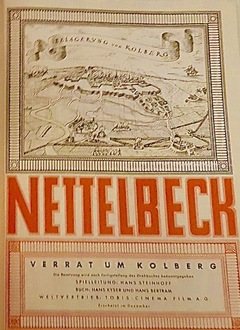
Tobis 1935/1936
Director: Hans Steinhoff
Script: Hans Kyser and Hans Bertram
The life of fighter and heroic defender of Kolberg, Nettelbeck, is well known.
Next to this masterful figure and that of the brave Commander Gneisenau, the film is placed in the centre of a plot by a son of a rich Kolberg citizen, who, from his knowledge of the French, endorsed the handover of the city to the French. In great dramatic scenes he attempts to win Nettelbeck and Gneisenau over but through their unbending will to the defence of the City, have the young hothead and friend of the French arrested.
The man blinded by Napolean's power will be expelled from the city, and in the harsh experiences of exile he will mature into a man, realizing his injustice. This Frenchman's friend, the cosmopolitan loudmouth who almost became a traitor to his hometown; becomes a serious, brave man, a fervent advocate of the fatherland idea. Risking his life, he horrifies the besieged fortress and brings salvation at the moment of greatest need. The cast will be announced after the script has been completed.
Opiumkrieg (The Opium War) – Tobis Filmkunst 1940/41
“Out of common greed and scrupulous profiteering, England slowly poisoned the Chinese people with its opium smuggled into China from India. High–ranking British bureaucrats and sanctimonious “Christian” missionaries enriched themselves through this contamination across the entire country. As responsible Chinese burned thousands of crates of opium in order to begin the fight against smuggling and corruption, the British through their fleet in Canton and other cities fired thousands of Chinese with grapeshot in the name of “civilization and mankind;” for “free trade” and the “pacification of China.” A chapter of English ignominy is illustrated in this film, from the background of historical accounts of poignant individual fates dramatically reported.”
Potsdam (Potsdam) – Ufa 1941/42
To be directed by renowned Carl Froelich, this film was to tell the story of “the residence of the Prussian Kings, the cradle of Prussian Germany, “ and its “world-historical perspective.”
Richard Wagner (Richard Wagner) – Hammer Tonfilm 1935/36
“No better time is it then today, to tell the path of destiny of the most German of all musicians. Richard Wagner, from the flop of the premiere of Tannhäuser in Paris to the complete recognition of his people and the entire world, is to re–emerge in a film. Dresden, Munich, Bayreuth and the Bavarian Kings' castles are the other locations of this truly folkish–heroic film, around the genius of Richard Wagner, to be directed by Hans Steinhoff, the very successful Director of “The young and old King.” The announcement promised “the most well–known German actors” would be engaged for the film.
Schicksal ohne Gnade (Destiny without Mercy) – Tobis Filmkunst 1941/42
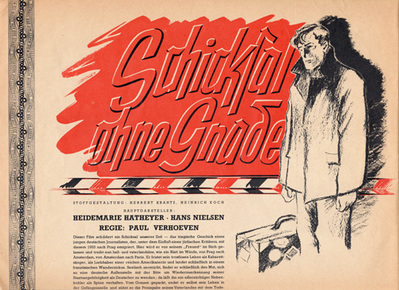 “This film portrays the destiny of our times – the tragic story of a young German journalist, who under the influence of a Jewish critic, emigrates with him to Prague in 1933. Here, he is left in the lurch by his “friend” and is now floating like a leaf in the wind, from Prague to Amsterdam, from Amsterdam to Paris. He ekes out a dreary existence as a cabaret singer, as the lover of a rich American, and winds up eventually in a travelling French circus. Mentally worn down, he eventually finds the courage to go to a German outpost with the request to recognize and bestow his German citizenship. A jealous rival makes him arrested as a spy. Gripped by horror, he ends his life in a prison cell, thus atoning for the abandonment of his fatherland with death.” This proposed Paul Verhoeven film was to have starred Heidemarie Hathheyer and Hans Nielsen.
“This film portrays the destiny of our times – the tragic story of a young German journalist, who under the influence of a Jewish critic, emigrates with him to Prague in 1933. Here, he is left in the lurch by his “friend” and is now floating like a leaf in the wind, from Prague to Amsterdam, from Amsterdam to Paris. He ekes out a dreary existence as a cabaret singer, as the lover of a rich American, and winds up eventually in a travelling French circus. Mentally worn down, he eventually finds the courage to go to a German outpost with the request to recognize and bestow his German citizenship. A jealous rival makes him arrested as a spy. Gripped by horror, he ends his life in a prison cell, thus atoning for the abandonment of his fatherland with death.” This proposed Paul Verhoeven film was to have starred Heidemarie Hathheyer and Hans Nielsen.
Segen der Arbeit (The Blessing of Work) – Tobis Filmkunst 1939/40
 “The film shows us the story of a village whose
“The film shows us the story of a village whose 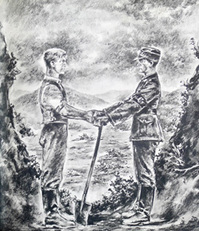 inhabitants for the most part earn their poor black bread by working in a slate mine. This mountain mine threatens to alienate the people from their actual task as farmers. Only the hero of this film recalls the farmer tradition of generations. He wants to make use once again of a giant tributary, over which the mine lies. To this task the members of the (Reich) Labor Service spring to his side as volunteers. A landslide, which occurred due to the mine work and which threatens the entire village, provides the Labor Service the opportunity to engage themselves heroically and to avert the danger at the last moment.” The intended Director was Heinz Paul (Douaumont, Kreuzer Emden.)
inhabitants for the most part earn their poor black bread by working in a slate mine. This mountain mine threatens to alienate the people from their actual task as farmers. Only the hero of this film recalls the farmer tradition of generations. He wants to make use once again of a giant tributary, over which the mine lies. To this task the members of the (Reich) Labor Service spring to his side as volunteers. A landslide, which occurred due to the mine work and which threatens the entire village, provides the Labor Service the opportunity to engage themselves heroically and to avert the danger at the last moment.” The intended Director was Heinz Paul (Douaumont, Kreuzer Emden.)
Staatsfeind Nr. 1 (Public Enemy Nr. 1) – Ufa 1937/38
“Public Enemy Nr. 1 – another film by Karl Ritter!
Public Enemy Nr. 1 – This term first surfaced in the USA. It was for those criminals who, because of their dangerousness to the entire US nation, are prosecuted by the Federal Police; regardless of the sovereign rights of the individual states of the United States.
Public Enemy Nr. 1– a gangster film? A criminal film of massive proportions? Conceived in Germany? No! Much more than that – Ufa has much more in mind!
Public Enemy Nr. 1 the film will be, which, like last year was shown in Verräter (Traitor) – a danger raised that threatened everything and at the same time the fate of men, who oppose it.
Public Enemy Nr. 1 is a film of a previously untold story, produced with the full commitment and support of the highest state and Party officials. This should ensure that this film is unique of its kind.”
Stein gib Brot! (Stone gives bread!) – Terra Filmkunst 1934/35
This film was based on a novel of the same name by Alfred Karrasch, who  wrote literature during the Third Reich, including NS propaganda, and was a NSDAP member. He was found to be a “fellow traveller” in his denazification process.
wrote literature during the Third Reich, including NS propaganda, and was a NSDAP member. He was found to be a “fellow traveller” in his denazification process.
The film tells the story of the sailors who transported gravel, sand and stone on their ship barges in the Baltic Sea, and their fall into unemployment and poverty in 1932, after their ships were iced in and destroyed by the tough winter, and the starvation that followed. The beaten–down people are filled with hatred towards the authorities who have let them go to the dogs. “One amongst them, the sailor Scholz, carries a new idea in his heart and belief in a new Leader who will come and eliminate all hardship – but he stands alone in his belief. The insanity reaches it’s dramatic resolution when the Chairman Corelsen, at the merciless auction of his stone ship, knocks down the auctioneer, and the court proceedings of dramatic power once again unfurl the huge need of the entire people through the fate of the defendant. Skipper Scholz despite all believes in a new Fatherland. Through fog and storm descends an aeroplane in which the poorest of the poor know has the Führer of the new Germany, and for the destiny of the people a turning point has opened. The small community of sixteen ships has experienced the wonder of new belief and re-emergence of a people.”
The Director was to be Frank Wysbar, music by composer Herbert Windt. No actors were listed.
Suez (Suez) – Ufa 1940/41
“It was the Tyrolean engineer, Alois Negrelli, who had the idea to join the Mediterranean to the Red Sea via a canal and thereby open a door to the world for Europe. It was a French diplomat, Ferdinand von Lesseps, who took possession of this thought and let it die. And it was an English Jew, the former British Prime Minister D’Israeli, who made the bold work, which was to serve the interests of all nations, into a business. The true story of the emergence of the Suez Canal - a theme that is burning, a film whose motives and events are in the midst of our defining days!” No Director or actors were listed. The Production Head was to be C.M.Köhn.
Wehrwolf (Werewolf) – Terra Filmkunst 1934/35
 “The heroic fight of Lüneberg Heath farmers for freedom and homeland, a grandiose portrait from the Thirty Years’ War.”
“The heroic fight of Lüneberg Heath farmers for freedom and homeland, a grandiose portrait from the Thirty Years’ War.”
When besieged farmers realize that enemy troops are marching towards Celle to establish winter quarters, they organize a resistance movement to be protected against the worst, and to not abandon the place without last resort.
Farmer Wulf is caught up in the war after trying to live in peace, and marauders, who murder, women, children and old inhabitants overtake the village and burn it to the ground. With this event, Farmer Wulf’s life takes its decisive turn. With the fanaticism of revolutionaries, the Werewolf resistance holds fearsome kangaroo courts against all enemies of the heath lands. Their leader Wulf places himself outside of every established law of state and war.
Betrayed, he is sentenced to death by hanging by the Duke. The entire heath rises up and marches to Celle to free him. In a dramatic turn of events, the Duke frees Wulf to lead the farmers against the outside enemy forces threatening the state. City and countryside, Duke and Wulf, have found one another.
The film stars were meant to be Heinrich George, Hertha Thiele, Peter Voss, Theodor Loos; the Director Frank Wysbar.
